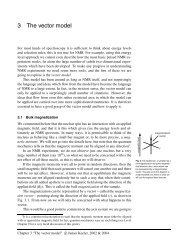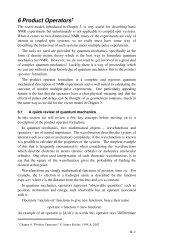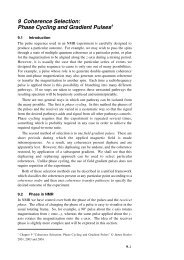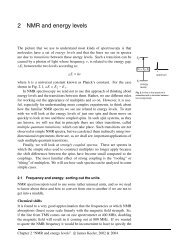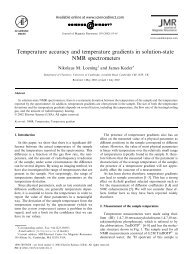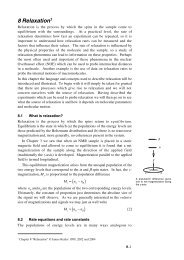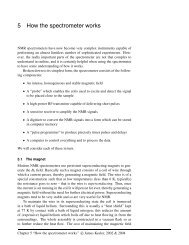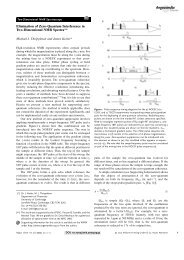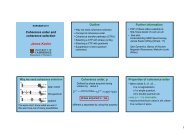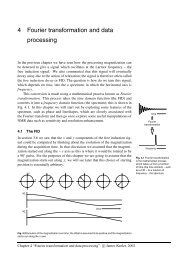Phase Cycling and Gradient Pulses - The James Keeler Group
Phase Cycling and Gradient Pulses - The James Keeler Group
Phase Cycling and Gradient Pulses - The James Keeler Group
You also want an ePaper? Increase the reach of your titles
YUMPU automatically turns print PDFs into web optimized ePapers that Google loves.
We start out the discussion by considering the refocusing of coherences,<br />
illustrated opposite. <strong>The</strong> net phase, Φ, at the end of such a sequence is<br />
( p) ( p')<br />
Φ = Ω δ + spγBgτ + Ω δ + sp'<br />
γBgτ<br />
where Ω ( p)<br />
is the frequency with which coherence of order p evolves in the<br />
( − p) ( )<br />
absence of a gradient; note that Ω =−Ω<br />
p . <strong>The</strong> net phase is zero if, <strong>and</strong><br />
only if, p' = –p. With sufficiently strong gradients all other pathways remain<br />
dephased <strong>and</strong> the gradient sequence thus selects the refocused component. As<br />
is expected for a spin echo, the underlying evolution of the coherence (as would<br />
occur in the absence of a gradient) is also refocused by the selection of the<br />
pathway shown. Any transverse magnetization which an imperfect refocusing<br />
pulse might create is also dephased.<br />
Placing equal gradients either side of a refocusing pulse therefore selects the<br />
coherence transfer pathway associated with a perfect refocusing pulse. This<br />
selection works for all coherence orders so, in contrast to the discussion in<br />
section 9.6.3.1, there is no loss of signal. Such a pair of gradients are often<br />
described as being used to "clean up" a refocusing pulse, referring to their role<br />
in eliminating unwanted pathways.<br />
We cannot use gradients to select the pathway associated with an inversion<br />
pulse as p = 0 both before <strong>and</strong> after the pulse. However, we can apply a<br />
gradient after the pulse to dephase any magnetization which might be created<br />
by an imperfect pulse. Taking the process a step further, we can apply a<br />
gradient both before <strong>and</strong> after the pulse, with the two gradients in opposite<br />
directions. <strong>The</strong> argument here is that this results in the maximum dephasing of<br />
unwanted coherences – both those present before the pulse <strong>and</strong> those that might<br />
be generated by the pulse. Again, this sequence is often described as being<br />
used to "clean up" an inversion pulse.<br />
In heteronuclear experiments an inversion pulse applied to one nucleus is<br />
used to refocus the evolution of a coupling to another nucleus. For example, in<br />
the sequence shown opposite the centrally placed S spin 180° pulse refocuses<br />
the IS coupling over the period 2δ. <strong>The</strong> pair of gradients shown have no net<br />
effect on I spin coherences as the dephasing due to the first gradient is exactly<br />
reversed by the second. <strong>The</strong> gradient sequence can be thought of as "cleaning<br />
up" the S spin inversion pulse.<br />
9.6.4.1 <strong>Phase</strong> errors due to gradient pulses<br />
For the desired pathway, the spatially dependent phase created by a gradient<br />
pulse is refocused by a subsequent gradient pulse. However, the underlying<br />
evolution of offsets (chemical shifts) <strong>and</strong> couplings is not refocused, <strong>and</strong> phase<br />
errors will accumulate due to the evolution of these terms. Since gradient<br />
pulses are typically of a few milliseconds duration, these phase errors are<br />
substantial.<br />
RF<br />
δ<br />
180°<br />
g τ τ<br />
p<br />
p'<br />
<strong>Gradient</strong> sequence used to<br />
"clean up" a refocusing pulse.<br />
Note that the two gradients are<br />
of equal area. <strong>The</strong> refocused<br />
pathway has p' = –p.<br />
RF<br />
g<br />
τ<br />
180°<br />
<strong>Gradient</strong> sequence used to<br />
"clean up" an inversion pulse.<br />
I<br />
S<br />
g<br />
δ<br />
τ<br />
τ<br />
180°<br />
In a heteronuclear experiment<br />
(separate pulses shown on the<br />
I <strong>and</strong> S spins) a 180° pulse on<br />
the S spin refocuses the IS<br />
coupling over the period 2δ.<br />
<strong>The</strong> gradient pulses shown are<br />
used to "clean up" the inversion<br />
pulse.<br />
τ<br />
δ<br />
δ<br />
9–39



